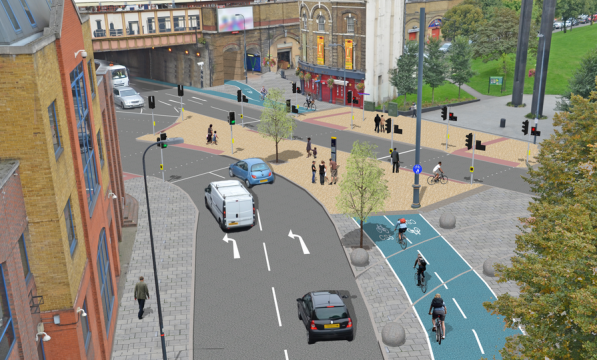Huge improvement in design of Cycle Superhighway 5

This is the second consultation on Cycle Superhighway 5 (CS5) - the first design showed little imagination and an unwillingness to remove motor traffic capacity.
The new design is much bolder: the two-way cycle track running along the north side of the bridge is wide and protected by new turning bans, prohibiting crossing motor traffic movements.
The cycle track will be a minimum of 3m, but mostly up to 4 or even 5 metres in places.
Over 3,500 cyclists use Vauxhall Bridge each day - 45% more than in 2000, but the bridge also carries 48,000 motor vehicles (down 10% from 2000), including 2,400 buses.
The new design is a huge improvement over what is there previous, and what had previously been proposed. Cycle tracks up to 5 metres wide show what can be done when Transport for London wants to make space for cycling.
Chris Peck
CTC
This section is just a small part of the full CS5 route, which was initially planned to run from Victoria to New Cross.
The route has also given up on Vauxhall Bridge Road, and instead diverts people either to backstreets to the west (e.g. Belgrave Road) or east (Regency Street/John Islip Street). This slightly undermines the principal that lay behind the original 'Superhighway' idea, which acknowledged the fact that main roads often provided the most direct route from A-B, and should still be made safe and attractive for cycling, even if quiet backstreets could sometimes offer reasonable alternatives.
Cycle Superhighway 7 tweaked
Just to the south of the CS5 scheme, Cycle Superhighway 7 already travels from south west London to the City of London. This was one of the first routes to be built (4 years ago) and was often little more than a strip of paint through bus lanes.
One of the worst conflict points was at Oval, where Brixton Road joins Kennington Park Road from the south. A conflict existed between drivers turning left onto Brixton Road, and cyclists heading straight ahead on CS7. A new design for this section sees the Brixton Road traffic slowed and separated from cyclists with a dedicated cycle track and separate cycle phase.
Both sections show remarkable improvement in standards of cycle provision.

